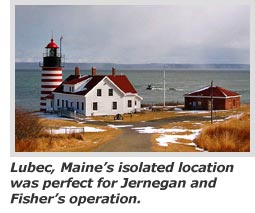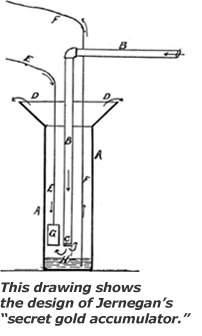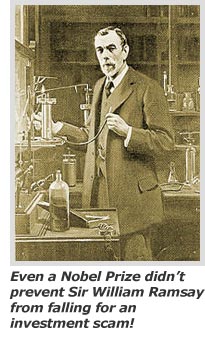The Gold Rush in the Sea - Electrolytic Marine Salts
Commodities / Gold & Silver Stocks Jul 11, 2007 - 08:11 AM GMTSean Brodrick writes: I was raised in Maine, and I'm visiting my old stomping grounds right now. One thing I've always liked about this great state is its rich history. Just about everything has happened here once (and sometimes twice).
Case in point: The other day I was walking around Portland. As I came across all kinds of interesting street names — "Gold," "Silver," "Market," and "Exchange" just to name a few — I was reminded of perhaps the strangest story to ever come out Maine. It's the tale of the 1898 gold rush in Lubec, Maine.
Today, I want to tell you about it. Not only will it make for great conversation at your next family barbecue, it also holds important lessons for investors …
The Rise of the Electrolytic Marine Salts Company
Gold is found in Maine's bedrock, in sediments that were eroded by glaciers, and in stream deposits. Most of the state's gold comes from placer deposits in stream beds. They were the source of significant gold discoveries in both the towns of Acton and Madrid, as well as smaller finds around the state.
But in 1898, two men showed up in Lubec, Maine with another astounding way to find gold in Maine: A process to harvest the yellow metal from sea water.

Now, Lubec is best described as "remote." It's the easternmost town in the U.S., way up near the Canadian border. That's probably why the two men — Rev. Prescott F. Jernegan and his boyhood friend Charles E. Fisher — chose Lubec for the construction of their "Klondike factory."
Jernegan, however, explained that Lubec was the perfect site for the Klondike factory because its position on the Passamaquoddy Bay gave it exposure to the huge rise and fall of the tides.
The official name of the company was the Electrolytic Marine Salts Company, or EMS. Jernegan and Fisher sold their secret formula to their new company in exchange for 45% of sales of company stock. According to Jernegan, the formula was the end result of over 200 experiments using electricity and chemistry.
Investors lined up to buy shares of the company. After all …
- Both Jernegan and Fisher came from respected Martha's Vineyard families.
- Jernegan was a Baptist minister. His workmen were required to participate in regular Sunday prayer services.
- EMS poured money into the project, installing the town's first telephone and electric systems. The company even paid for half the cost of a new steel bridge, which would be used for hauling away the tons of gold EMS would harvest.
Jernegan was also a born salesman, with impressive communication skills. As the old timers in Maine say, "He could sell a werewolf a flea collar." And he relied on …
A Seductive Mix of Truth and Fiction
See, there is gold in seawater, but in very low concentrations — about one to two parts per 10 billion. Jernegan and Fisher said their revolutionary process could get around that.
Curious would-be investors who came to Lubec for the dog-and-pony show were led by Jernegan down some stairs and into a room beneath a wharf. There they saw 250 boxes, each containing a battery, some mercury, and a "secret recipe" of chemicals that would make Colonel Sanders green with envy.

These boxes, called "accumulators," were then lowered deep, deep into the tide-churned salt water. Visitors saw the boxes go down. And they saw other boxes brought up after a 24-hour accumulation period. Cracked open like clams, the boxes revealed their treasure — small but valuable deposits of gold and silver.
At this point in our story, it probably seems like Jernegan was doing most of the hard work selling the company, doesn't it? Well, Fisher had a special skill of his own … one that very few knew about … one that made him invaluable to the company. He was a trained deep-sea diver!
In other words, Fisher was just the type of man who could descend through the icy, inky-black depths of the nighttime sea and put gold in the accumulator boxes! As one local folklorist recalls, "The next day when it was low tide, they'd take these accumulators out and low and behold, there was gold!"
On May 11, 1898, a local newspaper reported: "Nine shipments have been made from the works of the Electrolytic Marine Salts Mining Co. of East Lubec to date. They are said to have averaged about $1,000 apiece in value."
Of course, nothing of the kind had happened — Jernegan and Fisher were seeding the press stories just like they were seeding the accumulator boxes. But investors fell for it hook, line and sinker, especially because they heard that Plant Number Two would have 5,000 more magic accumulator boxes.
By the end of May, the locals — many of whom now had jobs at EMS — were won over. The Lubec Herald gave Jernegan and Fisher a ringing endorsement, saying, "We believe that time will prove these gentlemen of the EMS Co. to be staunch friends and people who will take a warm interest in the town."
Locals dug up their hidden cash to get in on the initial offering of EMS shares. But that local Lubec money was small potatoes for the EMS boys. They aimed to hook the big money speculators. And man, did they land some whales!
EMS stock was offered at $1 per share. The first offering of 350,000 shares sold out in three days. By July, 2.4 million shares had been sold to investors all over the East Coast, as 800 workers raced to put the finishing touches on Plant Number One.
"The Biggest Swindling Scheme We Ever Had in Maine"
In July, Fisher left on business. A few days later, locals noticed that Jernegan was also missing. Concerned, some workers went to his home, where they found the entire family had vanished, taking their furniture with them. Mysteriously, all of the company books and ledgers had disappeared as well.
Now revealed, the EMS gold-from-seawater venture quickly turned into a major debacle. The July 29 Hartford Courant ran a banner headline: "The Bubble Burst." And EMS stock imploded, tumbling from $1.40 to $0.30 per share.
Warrants for Jernegan and Fisher were quickly issued, but both men had fled the country, their bags stuffed with cash. One Lubec local described the affair as "the biggest swindling scheme we ever had in Maine."
But That's Not the End of the Story …
Fisher was never seen again, but most reports suggest he died in Australia. Jernegan was discovered living in France. His wife and son had fled with him, but she later divorced him.
Upon discovery, Jernegan insisted he was trying to locate Fisher, who had taken valuable company records. The proper paperwork for Jernegan's arrest warrant didn't come through in time for French authorities to arrest him, and he slipped away, reportedly to the Philippines.
Meanwhile, several stockholders refused to give up hope. Still confident that gold could be wrung from seawater, they kept at it for quite some time before finally throwing in the towel on the Electrolytic Marine Salts Company.

The defunct EMS Plant Number One was later converted into a sardine factory. And guess what? The sardine harvest brought more wealth to Lubec than the gold scheme ever promised to!
And here's one last amazing twist: In 1905 — just seven years after the Lubec scam — a company called the Industrial and Engineering Trust Ltd. proposed to use its "secret process" to extract gold from sea water along the English coast.
This scheme actually won the endorsement of Sir William Ramsay, a British winner of the Nobel Prize for Chemistry! Like so many others, even the great scientist was snookered.
What Investors Can Learn from The Gold Rush in Lubec, Maine
First, always do your homework. That's why I crunch the numbers on companies I recommend, and fly hither and yon to check out the promising ones in person.
Second, don't get caught up in hype. Conventional wisdom is no path to real wealth. In fact, it can often work to your advantage to sell when others are buying.
Third, watch what the insiders are doing. Are they buying or selling? Are they experts in their field or just salesmen with slick haircuts and a song-and-dance? Putting your money to work with people who really know what they are doing is one way to stay ahead of the crowd.
If you want a great way to get some gold for the long haul, consider putting some money to work in one of the gold ETFs out there, such as the streetTRACKS Gold Shares (GLD) or the iShares COMEX Gold Trust (IAU).
And if you're interested in mines, you could try the Van Eck Market Vectors Gold Miners ETF ( GDX ) or the Metal and Mining SPDR ( XME ).
Yours for trading profits,
By Sean Brodrick
This investment news is brought to you by Money and Markets . Money and Markets is a free daily investment newsletter from Martin D. Weiss and Weiss Research analysts offering the latest investing news and financial insights for the stock market, including tips and advice on investing in gold, energy and oil. Dr. Weiss is a leader in the fields of investing, interest rates, financial safety and economic forecasting. To view archives or subscribe, visit http://www.moneyandmarkets.com .
Money and Markets Archive |
© 2005-2022 http://www.MarketOracle.co.uk - The Market Oracle is a FREE Daily Financial Markets Analysis & Forecasting online publication.



